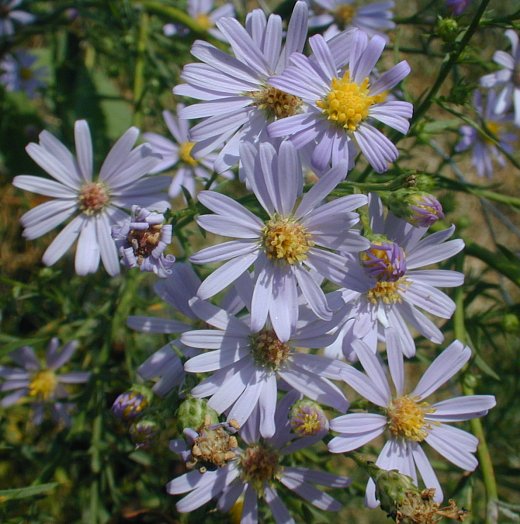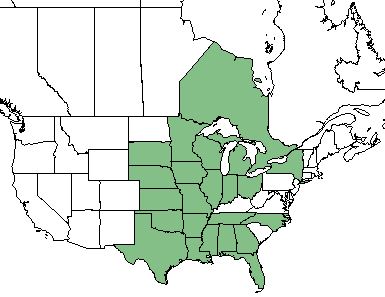Difference between revisions of "Symphyotrichum oolentangiense"
| (4 intermediate revisions by 3 users not shown) | |||
| Line 31: | Line 31: | ||
==Ecology== | ==Ecology== | ||
===Habitat=== <!--Natural communities, human disturbed habitats, topography, hydrology, soils, light, fire regime requirements for removal of competition, etc.--> | ===Habitat=== <!--Natural communities, human disturbed habitats, topography, hydrology, soils, light, fire regime requirements for removal of competition, etc.--> | ||
| − | ''S. oolentangiense'' occurs in prairies, pine woods, oak woods, sand dunes, river banks, and glades.<ref name="Weakley 2015"/><ref name="FSU"> Florida State University Herbarium Database. URL: http://herbarium.bio.fsu.edu. Last accessed: June 2021. Collectors: Loran C. Anderson, Wilson Baker, H. R. Bennett, and R.K. Godfrey. States and counties: Florida: Gadsden, Leon, and Liberty Georgia: Thoams. Indiana: Porter.</ref> It is also found in disturbed areas like woodland remnants.<ref name="FSU"/> It prefers mesic to dry soils.<ref name="Ladybird"/> ''S. oolentangiense'' does not respond to soil disturbance by clearcutting and chopping in | + | ''S. oolentangiense'' occurs in prairies, pine woods, oak woods, sand dunes, river banks, and glades.<ref name="Weakley 2015"/><ref name="FSU"> Florida State University Herbarium Database. URL: http://herbarium.bio.fsu.edu. Last accessed: June 2021. Collectors: Loran C. Anderson, Wilson Baker, H. R. Bennett, and R.K. Godfrey. States and counties: Florida: Gadsden, Leon, and Liberty Georgia: Thoams. Indiana: Porter.</ref> It is also found in disturbed areas like woodland remnants.<ref name="FSU"/> It prefers mesic to dry soils.<ref name="Ladybird"/> ''S. oolentangiense'' does not respond to soil disturbance by clearcutting and chopping in north Florida flatwoods forests.<ref>Moore, W.H., B.F. Swindel, and W.S. Terry. (1982). Vegetative Response to Clearcutting and Chopping in a North Florida Flatwoods Forest. Journal of Range Management 35(2):214-218.</ref> |
| + | |||
| + | Associated species: ''Schoenus, Aster patens, A. lateriflorus'', and ''Juniperus''.<ref name="FSU"/> | ||
===Phenology=== <!--Timing off flowering, fruiting, seed dispersal, and environmental triggers. Cite PanFlora website if appropriate: http://www.gilnelson.com/PanFlora/ --> | ===Phenology=== <!--Timing off flowering, fruiting, seed dispersal, and environmental triggers. Cite PanFlora website if appropriate: http://www.gilnelson.com/PanFlora/ --> | ||
| Line 37: | Line 39: | ||
<!--===Seed dispersal===--> | <!--===Seed dispersal===--> | ||
<!--===Seed bank and germination===--> | <!--===Seed bank and germination===--> | ||
| − | |||
| − | ===Pollination=== | + | ===Fire ecology=== <!--Fire tolerance, fire dependence, adaptive fire responses--> |
| + | Populations of ''Symphyotrichum oolentangiense'' have been known to persist through repeated annual burning.<ref>Platt, W.J., R. Carter, G. Nelson, W. Baker, S. Hermann, J. Kane, L. Anderson, M. Smith, K. Robertson. 2021. Unpublished species list of Wade Tract old-growth longleaf pine savanna, Thomasville, Georgia.</ref> | ||
| + | |||
| + | ===Pollination and use by animals=== | ||
This species is known to attract butterflies and many species of native bees.<ref name="Ladybird"/> | This species is known to attract butterflies and many species of native bees.<ref name="Ladybird"/> | ||
| − | |||
<!--==Diseases and parasites==--> | <!--==Diseases and parasites==--> | ||
Latest revision as of 19:36, 16 August 2021
| Symphyotrichum oolentangiense | |
|---|---|

| |
| Photo by | |
| Scientific classification | |
| Kingdom: | Plantae |
| Division: | Magnoliophyta - Flowering plants |
| Class: | Magnoliopsida - Dicots |
| Order: | Asterales |
| Family: | Asteraceae |
| Genus: | Symphotrichum |
| Species: | S. oolentagiense |
| Binomial name | |
| Symphyotrichum oolentangiense (Riddell) G.L. Nesom | |

| |
| Natural range of Symphyotrichum oolentangiense from USDA NRCS Plants Database. | |
Common Name(s): azure aster;[1] skyblue aster[2]
Contents
Taxonomic Notes
Synonym(s): Aster oolentangiensis; A. azureus var. azures[1]
Varieties: S. oolentangiense var. laevicaule; S. oolentangiense var. oolentangiense[1]
Description
Symphyotrichum oolentangiense is a dioecious perennial[2][3] that grows as a 1-3 ft (0.30-0.91 m) forb/herb or subshrub.[2] It produces a bluish purplish flower with yellow center.[3]
Distribution
S. oolentangiense is found from New York to Minnesota and South Dakota, south to the Florida Panhandle westward to Texas, although it is absent in several states along the Atlantic coast.[1][2]
Ecology
Habitat
S. oolentangiense occurs in prairies, pine woods, oak woods, sand dunes, river banks, and glades.[1][4] It is also found in disturbed areas like woodland remnants.[4] It prefers mesic to dry soils.[3] S. oolentangiense does not respond to soil disturbance by clearcutting and chopping in north Florida flatwoods forests.[5]
Associated species: Schoenus, Aster patens, A. lateriflorus, and Juniperus.[4]
Phenology
Flowering occurs from August through November.[1]
Fire ecology
Populations of Symphyotrichum oolentangiense have been known to persist through repeated annual burning.[6]
Pollination and use by animals
This species is known to attract butterflies and many species of native bees.[3]
Conservation and Management
Cultivation and restoration
Photo Gallery
References and notes
- ↑ 1.0 1.1 1.2 1.3 1.4 1.5 Weakley AS (2015) Flora of the Southern and Mid-Atlantic States. Chapel Hill, NC: University of North Carolina Herbarium.
- ↑ 2.0 2.1 2.2 2.3 USDA NRCS (2016) The PLANTS Database (http://plants.usda.gov, 12 January 2018). National Plant Data Team, Greensboro, NC 27401-4901 USA.
- ↑ 3.0 3.1 3.2 3.3 Plant database: Symphyotrichum oolentangiense. (12 January 2018) Lady Bird Johnson Wildflower Center. URL: https://www.wildflower.org/plants/result.php?id_plant=SYOO
- ↑ 4.0 4.1 4.2 Florida State University Herbarium Database. URL: http://herbarium.bio.fsu.edu. Last accessed: June 2021. Collectors: Loran C. Anderson, Wilson Baker, H. R. Bennett, and R.K. Godfrey. States and counties: Florida: Gadsden, Leon, and Liberty Georgia: Thoams. Indiana: Porter.
- ↑ Moore, W.H., B.F. Swindel, and W.S. Terry. (1982). Vegetative Response to Clearcutting and Chopping in a North Florida Flatwoods Forest. Journal of Range Management 35(2):214-218.
- ↑ Platt, W.J., R. Carter, G. Nelson, W. Baker, S. Hermann, J. Kane, L. Anderson, M. Smith, K. Robertson. 2021. Unpublished species list of Wade Tract old-growth longleaf pine savanna, Thomasville, Georgia.